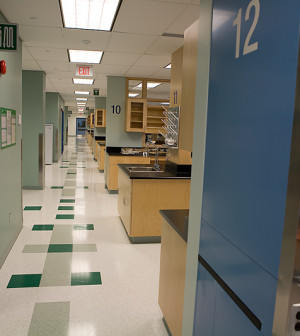- Skip Storing This Everyday Product in the Fridge Door
- Green Tea + B3 Pairing May Boost Brain Health
- Navigating Your Midlife Crisis: Embracing New Possibilities
- City Raccoons Showing Signs of Domestication
- Mapping the Exposome: Science Broadens Focus to Environmental Disease Triggers
- One Week Less on Social Media Linked to Better Mental Health
- Your Brain Changes in Stages as You Age, Study Finds
- Some Suicide Victims Show No Typical Warning Signs, Study Finds
- ByHeart Formula Faces Lawsuits After Babies Sickened With Botulism
- Switch to Vegan Diet Could Cut Your Greenhouse Gas Emissions in Half
How the Brain Reads Other People’s Faces

One area of the brain appears to be responsible for recognizing facial expressions, a new study finds.
Ohio State University researchers monitored the brain activity of 10 college students as they were shown more than 1,000 photographs of people making different facial expressions. The expressions fell into several categories: disgusted, happily surprised, happily disgusted, angrily surprised, fearfully surprised, sadly fearful, and fearfully disgusted.
The experiments revealed that the area responsible for recognizing facial expressions seems to be on the right side of the brain behind the ear. The area is called the posterior superior temporal sulcus (pSTS).
The researchers also found that nerve patterns within the pSTS seem to be programmed to recognize movement in certain areas of the face. For example, one neural pattern identifies a furrowed brow and another detects the upturned lips of a smile, the researchers said.
“That suggests that our brains decode facial expressions by adding up sets of key muscle movements in the face of the person we are looking at,” study author Aleix Martinez said in a university news release. Martinez is a cognitive scientist and professor of electrical and computer engineering at Ohio State.
“Humans use a very large number of facial expressions to convey emotion, other non-verbal communication signals and language,” Martinez said.
“Yet, when we see someone make a face, we recognize it instantly, seemingly without conscious awareness. In computational terms, a facial expression can encode information, and we’ve long wondered how the brain is able to decode this information so efficiently,” he explained.
Martinez added that researchers now know that a small part of the brain is devoted to this job.
Study co-author Julie Golomb is an assistant professor of psychology and director of the university’s Vision and Cognitive Neuroscience Lab. She said that “this work could have a variety of applications, helping us not only understand how the brain processes facial expressions, but ultimately how this process may differ in people with autism, for example.”
The study was published in the April 19 issue of the Journal of Neuroscience.
More information
The American Psychological Association has more on facial expressions.
Source: HealthDay
Copyright © 2025 HealthDay. All rights reserved.










